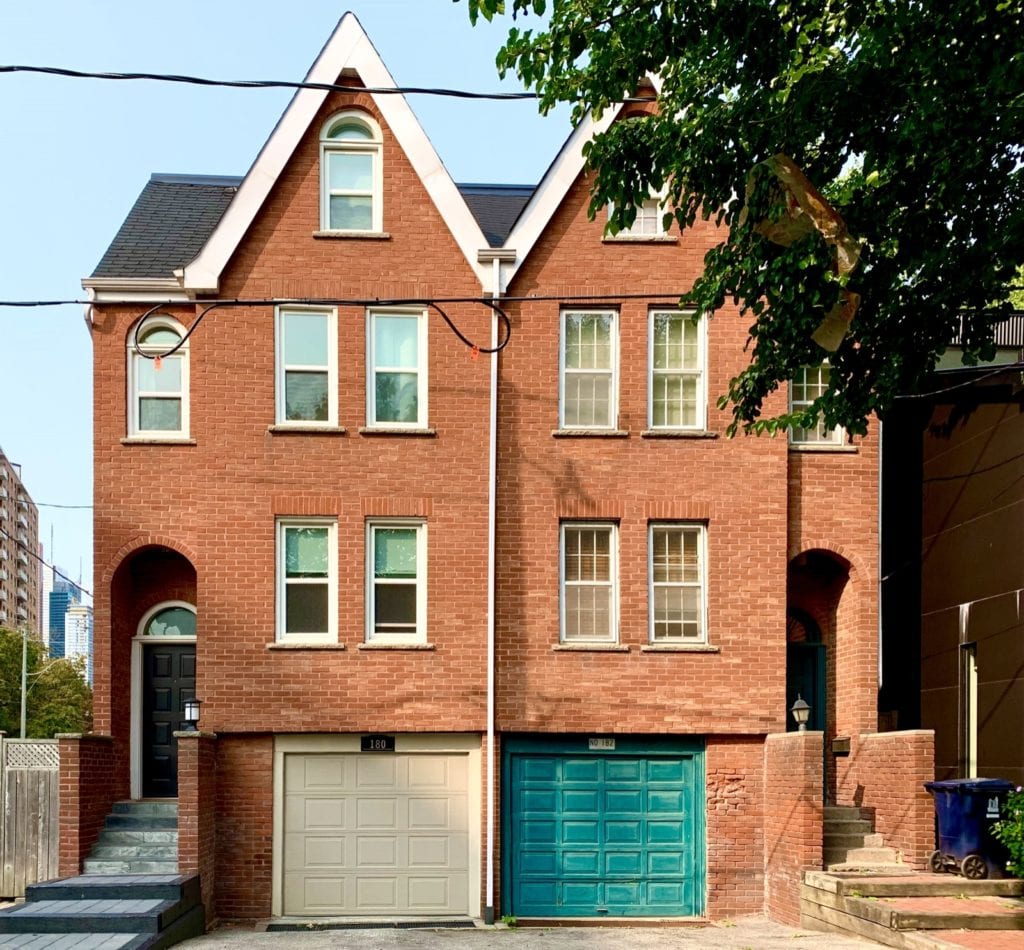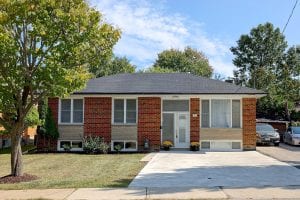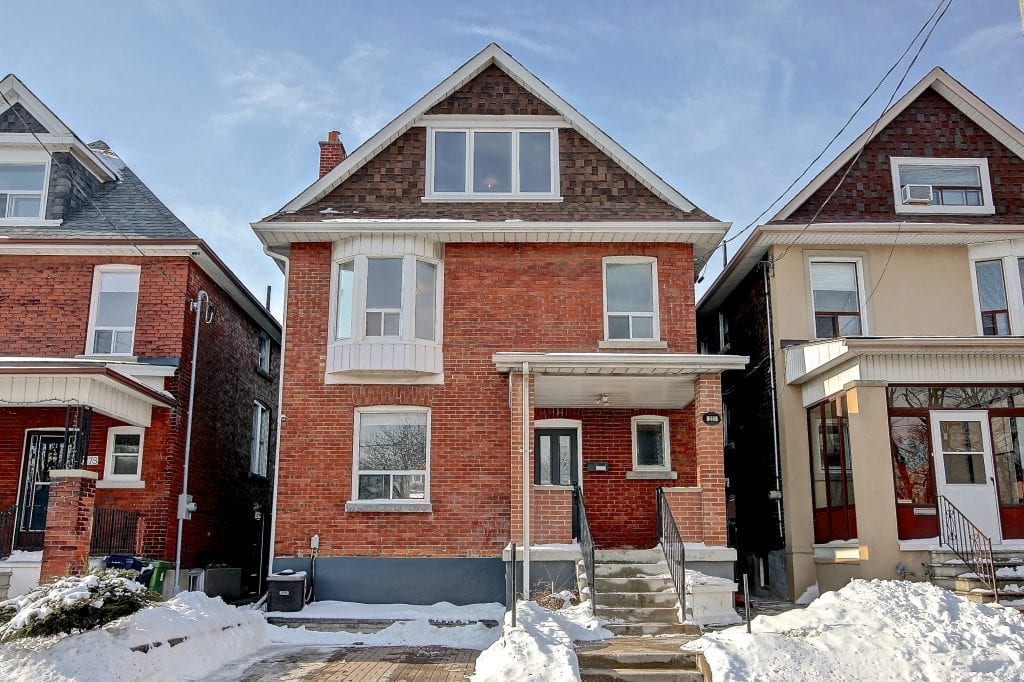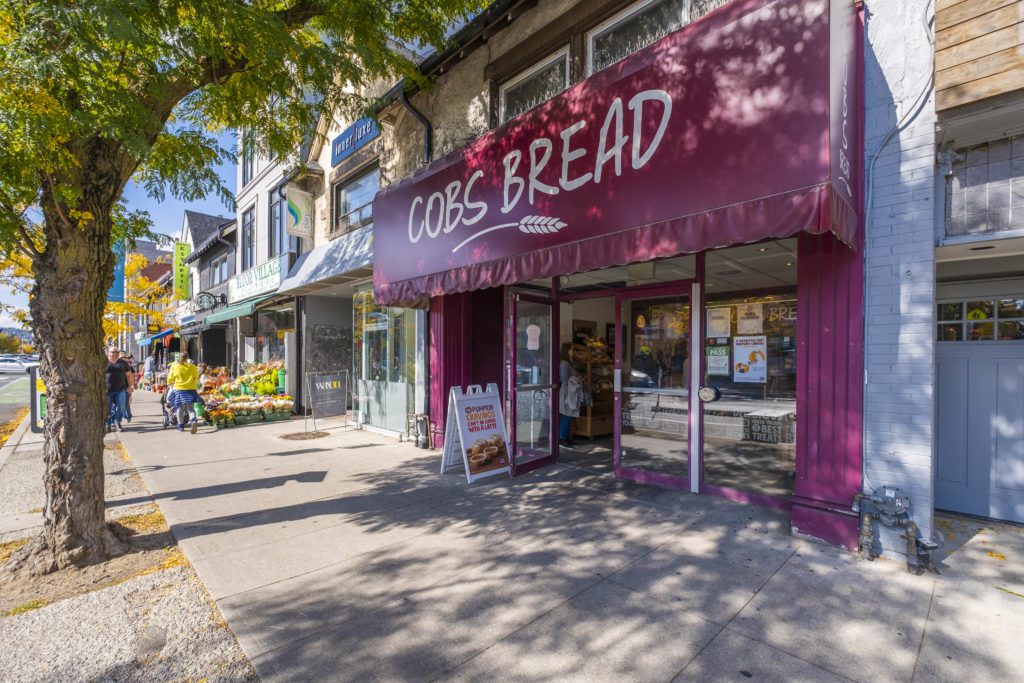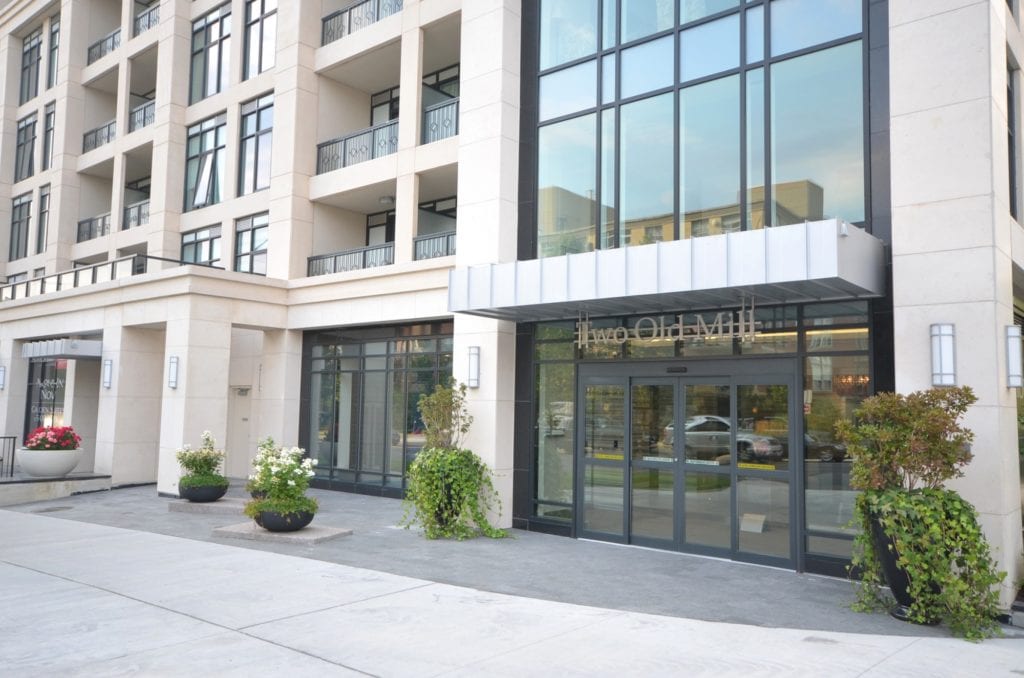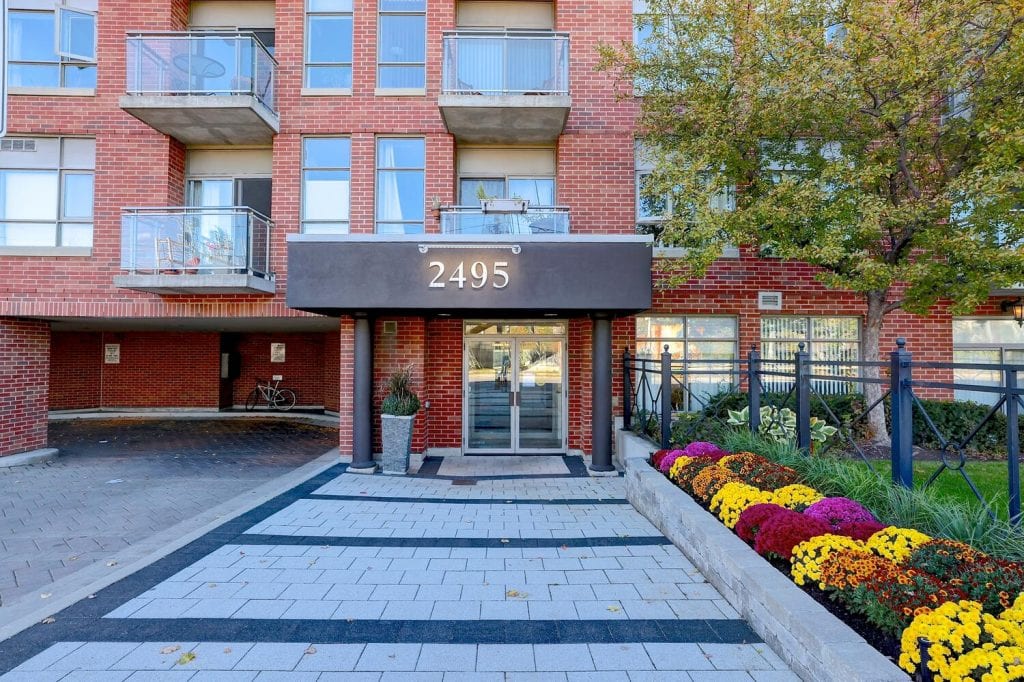Author: Dave Proulx
Coronavirus Threatens Survival of Toronto Small Businesses
04/25/20

The Broadview-Danforth Business Improvement Association (on behalf of dozens of Toronto BIAs) recently surveyed 561 small business tenants and 137 landlords across the city as to how the Coronavirus lockdown has affected them. A majority of the respondents (61%) said that they would not survive over the next 3 months without rent relief, and 76% said that they would have to close down for good within 5 months.
Another recent survey, conducted by Restaurants Canada, concluded that, if conditions don’t improve within three months, 50% of independent restaurants won’t survive, and most multi-unit foodservice businesses will have to permanently close at least one of their locations. Most of these businesses are extremely concerned about the amount of additional debt they will have accumulated when the crisis is past, even if they do manage to survive.
Restaurants Canada received a total of 914 completed surveys from foodservice operators across Canada, representing 11,856 locations (as many respondents belong to multi-unit businesses). Canada’s commercial foodservice industry is made up of 97,500 establishments, including full-service restaurants, quick-service restaurants, caterers and drinking places. A very large number of jobs are involved, so say the least.
While the federal government has announced the ‘Canada Emergency Commercial Rent Assistance’ program, which will provide loans to small businesses to provide some rent relief, there are concerns that loans will only delay the problem until later.
These snapshots show how serious the impact of the business closures has been, and how much worse it will get as the lock-down drags on. It’s simply not possible to switch off the economy and expect everything to go back to ‘normal’ quickly once the switch is turned back on. Government money will cushion the blow to some extent, but government spending will not substitute for lost economic activity, nor will it replace lost jobs and businesses.
Obviously, the real estate market has also felt the effects of the virus. Since the lock-down started, sales of homes and condos have been cut by more than two thirds and, while prices have held up remarkably well, the knock-on effects on the economy of the reduced activity (fewer renovations, appliance & furniture sales, etc) will be more and more significant as time goes on. Plus, many people will emerge from the crisis with more debt than ever: this could make buyers reluctant to purchase until they have repaired their balance sheets; and some people may need to sell. And another potential impact: the stresses of forcible confinement could lead to a surge in marriage break-ups leading to family homes being put up for sale. Rather than a strong ‘bounce-back’ later this year, we might instead have a sustained buyers’ market (more sellers than buyers) and falling prices for the first time in more than 20 years. Good news, perhaps, for millennials who have had a tough time affording a home for many years, but still, the longer the lock-down continues, the larger the negative impact on both the real estate market and the economy as a whole.
As we learn more about the extent of the damage being done to the economy, we are also learning more about the coronavirus itself. For example, while there is still much that is not known about the virus, there is evidence from many sources that the virus is much less lethal than was indicated by early information. We also know that the virus is much more lethal among the elderly and those with other health problems, while young, healthy people often have only mild symptoms or none at all. SARS CoV-2 is a very nasty virus to be sure, but we need to maintain some perspective and to dial back the fear and hysteria rather than continuing to feed it.
It is certainly sensible that we continue to encourage social distancing; to discourage people from congregating in large groups; and in particular to focus on protecting the elderly and immunocompromised among us. However, we also need to re-open the economy and get people back to work as soon as we can safely do so. The virus will probably be with us for a long time (it’s unlikely there will be an effective vaccine any time soon, if ever), and most people will follow the rules well enough to ‘keep the curve flattened’ and prevent overloading our health care system while the virus continues to spread slowly through the population. After all, the goal from the beginning was to slow the spread of the virus, not to eliminate the risk of being infected. As stated in the federal government’s guidance publication, Public health measures: Canadian Pandemic Influenza Preparedness: Planning Guidance for the Health Sector:
“When planning public health measures, decision-makers must weigh not just the costs of implementation but also any secondary impacts. Social and economic impacts on individuals, families, communities and businesses due to, for example, closing schools or cancellation of public events, should be considered with any intervention and weighed against its potential benefit. Individual behavioural measures, such as practicing hand hygiene, respiratory etiquette and self-isolation when ill, are promoted during seasonal influenza and should be encouraged in any pandemic scenario. Other measures, such as school closures and border restrictions, are complex, costly to sustain and likely to have unintended societal and economic consequences.”
This document didn’t anticipate the unprecedented actions that have closed down significant portions of the economy but, of course, the same principle of weighing costs versus benefits must apply. A lot of economic damage has already been done and, even if the economy were to be opened up today, it would be quite some time before businesses would return to something resembling normal. Many jobs may have been permanently lost. It is critical that the authorities constantly seek to strike the right balance between minimizing the impact of the virus on public health versus on our economic well-being. Both are vitally important.
Sign Up For Our Newsletter
Looking for more great real estate content? Get it delivered to your inbox with our newsletter!
Canadian Government Supporting Mortgage Market
04/15/20

Soon after the COVID-19 lock-downs began last month, signs started to appear that the mortgage market was headed for a credit freeze, where mortgage lenders would be unable or unwilling to keep lending to homebuyers. A credit freeze would likely crash the real estate market – if mortgage lending isn’t possible, home sales would collapse and prices would fall off a cliff.
However, the government is aware that the housing market is critically important to the Canadian economy – in effect, it’s ‘too big to fail’ – and so they took aggressive action very quickly to head off the problem.
Canada Mortgage and Housing Corporation (CMHC, the government owned mortgage insurer) will be buying $150 billion worth of mortgages from mortgage lenders. Similar to Quantitative Easing, CMHC will buy ‘packaged’ mortgage loans (basically mortgage backed securities) from banks, providing the banks with cash to keep making mortgage loans as well as providing a cushion against losses due to individuals and business not making payments or even defaulting. CMHC did the same thing during the 2008 financial crisis, but this time is committing more than twice as much money, amounting to about 10% of the total Canadian mortgage debt. The Bank of Canada will be also be buying up mortgage debt at the rate of $2 billion per month for as long as they feel it’s necessary.
That the government is liable for mortgage defaults is nothing new – CMHC has been insuring banks against mortgage defaults for a long time. What’s different is that we now have an actual state-owned mortgage lender.
Full marks to the government for taking these steps – and so far it seems to be working.
Sign Up For Our Newsletter
Looking for more great real estate content? Get it delivered to your inbox with our newsletter!
Canadian Consumer Confidence Falls
04/10/20

The Conference Board of Canada’s Index of Consumer Confidence fell by 32 points in March, the largest monthly decline ever. Canadians are clearly anxious about the coronavirus, and are mostly staying home both because the government is encouraging them to do so and also because they are afraid of venturing outside more than absolutely necessary.
Consumers are concerned about future job prospects and that their financial situation will get worse. Accordingly, many feel that this is a bad time to make a major purchase.
Click here to see the Conference Board report.
Truth is, the government response to the coronavirus will have a significant and lasting impact on jobs and on the economy. This would be bad enough, but the negative consumer psychology could make it worse. Many people will have their finances significantly impaired by the lock-down and will be in no position to buy real estate or make other major purchases. Many others, however, may still be in good financial shape but simply be afraid to buy anything out of concern that the virus might return, the economy might continue to get worse, and/or they might still lose their job.
The combination of a weak economy and a fearful, timid consumer could set up a downward spiral, where the worse things get, the more people will tend to hunker down, buy less and save their money which, of course, will make things even worse.
We definitely need to work more on ’emphasizing the positive’ about how the virus is coming under control, how people are getting back to work, how businesses are up and running. We need as much good news as possible about how everything is getting better, and less bad news about how many more people got sick or died today and how dangerous the virus is.
It’s time for the media and government officials to step up to the plate and start instilling hope instead of fear.
Sign Up For Our Newsletter
Looking for more great real estate content? Get it delivered to your inbox with our newsletter!
COVID-19 Thins Out Toronto Market
04/08/20
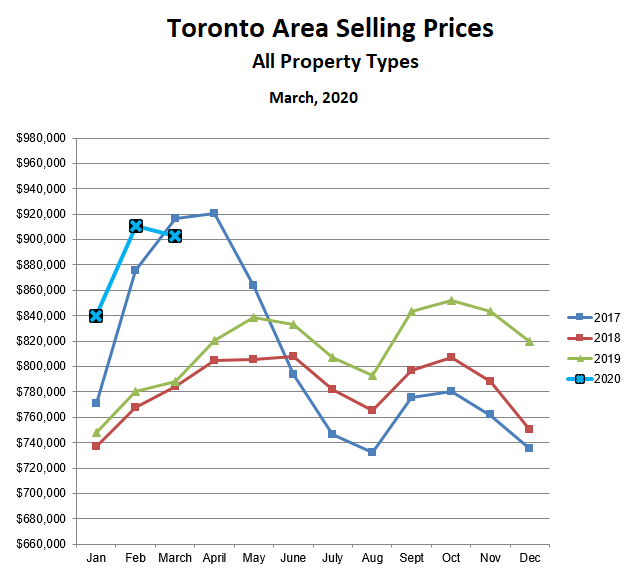
Oh what a difference a month has made.
Overall, results for the month of March were very good, though not quite as strong as February. Total sales were up by 10% and, while active listings were up by 20%, the overall inventory of homes for sale was only slightly higher than in February and still comfortably in ‘sellers’ market’ territory.
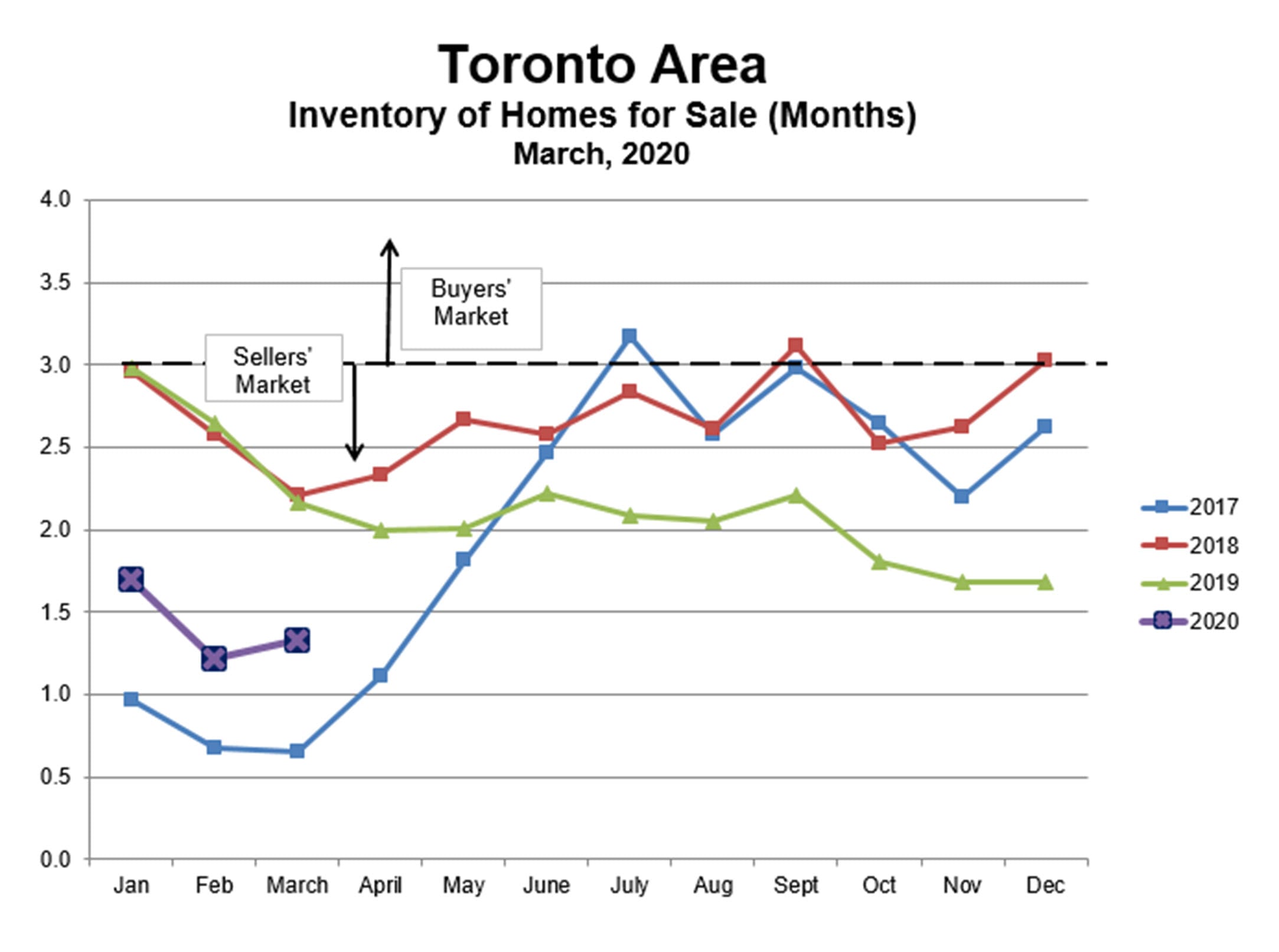
Prices fell slightly for all property types, but remained well above 2019 levels.

However, the overall results mask what happened to the market in late March when the government of Ontario called a halt to all non-essential businesses and strongly encouraged everyone to stay at home and observe social distancing. Because of these restrictions, real estate activity has fallen steeply, with less than half as many homes being sold per week at the end of March as compared with the beginning of the month.
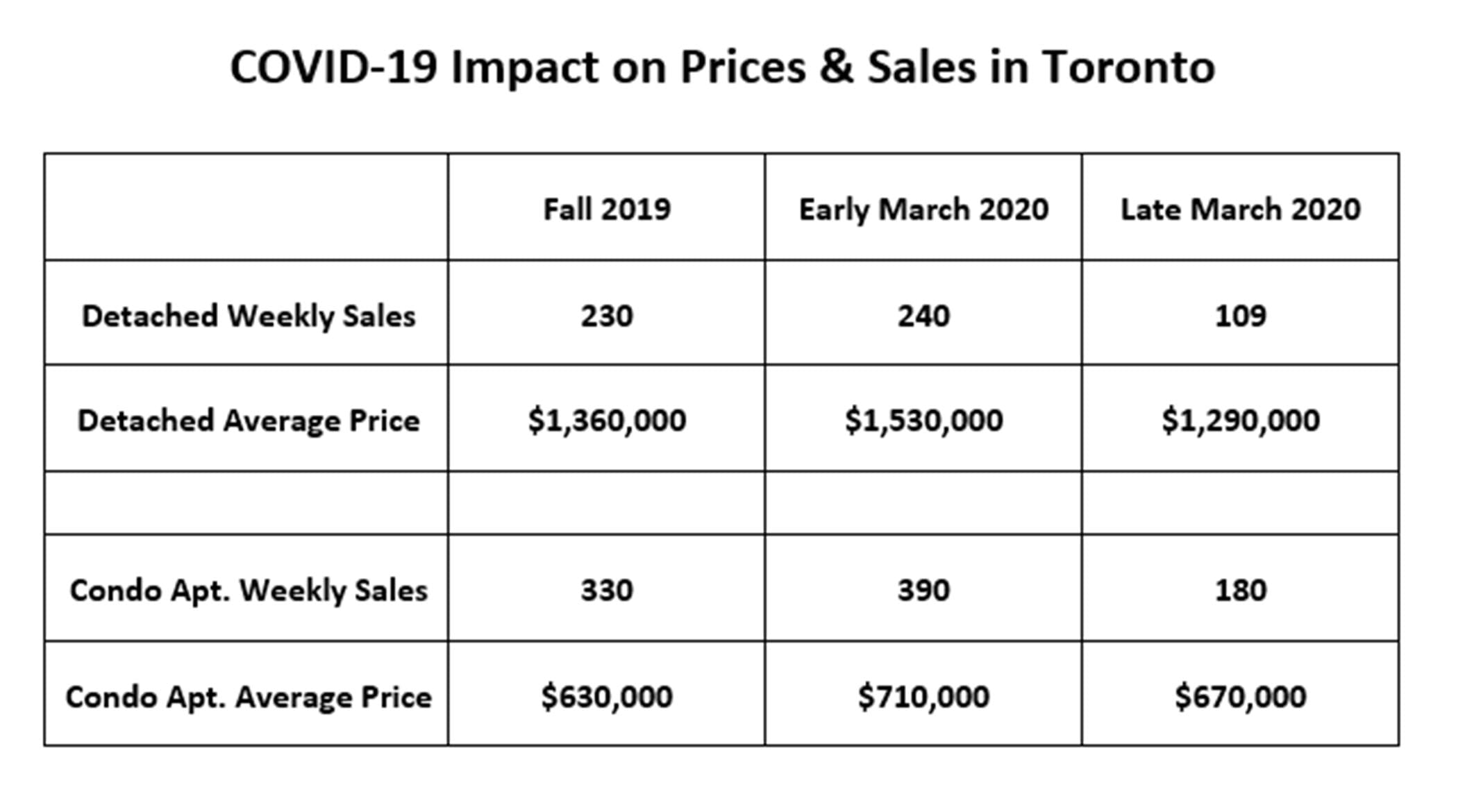
Prices have also declined since the COVID-19 restrictions came into effect. As shown in the chart above, for example, prices for detached homes in metro Toronto were 12% higher than last fall in early March. However, COVID-19 has taken all of the air out of that emerging bubble, and, as of the last week of March, prices were about 5% below last fall.
For condominium apartments in metro Toronto, sales and prices also fell in late March, however, condo prices are still well above last fall.
The market has thinned out dramatically, with both sellers and buyers moving to the sidelines in large numbers until the COVID-19 crisis has passed. Prices have held up remarkably well under the circumstances, mostly because the inventory of homes for sale remains low. There are fewer buyers and fewer sellers, but still more of the former than of the latter.
How this situation will play out over the next few months is very hard to predict. One school of thought says that, once the “all clear” has sounded on COVID-19 restrictions, both buyers and sellers will return to the market with a vengeance, and both sales and prices will move upward vigorously.
On the other hand, the economy may not be in great shape by the time the virus crisis is past. This could cause buyers to be more cautious at a time when sellers who have delayed their plans decide to rush into the market. That would be a recipe for increasing inventory and a shift toward a buyers’ market as well as falling prices.
Interesting times indeed.
Sign Up For Our Newsletter
Looking for more great real estate content? Get it delivered to your inbox with our newsletter!
Selling Homes Safely In The Age Of COVID-19
04/05/20

Many people still need or want to buy or sell a home, even in the midst of the coronavirus pandemic. For example, some bought homes some time ago, and need to sell their present home; others have sold their homes and need to buy a new one.
We have instituted 5 key measures to ensure that buying and selling real estate can be done safely at this time:
- The property must be vacant – either no-one is living in the home, or the owners have moved out while their house is on the market.
- Maximize virtual access – we are providing floor plans, video tours, 3D virtual tours, plenty of photos, and detailed descriptions of the homes we have for sale. This allows buyers to decide if the home is for them and whether they want to arrange a visit. In this way, in-person visits to the home are minimized.
- We make it easy to view the home safely. Each morning, we turn on all the lights and make sure all the inside doors are open, so that the home can be viewed without touching anything. Then, at the end of the day, all the lights are turned off and the door knobs, key and lockbox are wiped down to make everything as sanitary as possible.
- Visitors are screened before they can enter the home. Both at the time the viewing is booked, and again at the front door, we ask that both the agent and the buyers confirm that they have not traveled in the past 21 days; that they do not have any cold or flu symptoms and have not been around anyone who does; that they use hand sanitizer (which we provide) before viewing the home; and that they touch as little as possible while in the home.
- Minimize the number of people in the home at once. For example, the buyer can view the home without their agent, and then they can change places so the agent can see it. That way, social distancing can be maintained.
Sign Up For Our Newsletter
Looking for more great real estate content? Get it delivered to your inbox with our newsletter!
Trinity Bellwoods
04/02/20
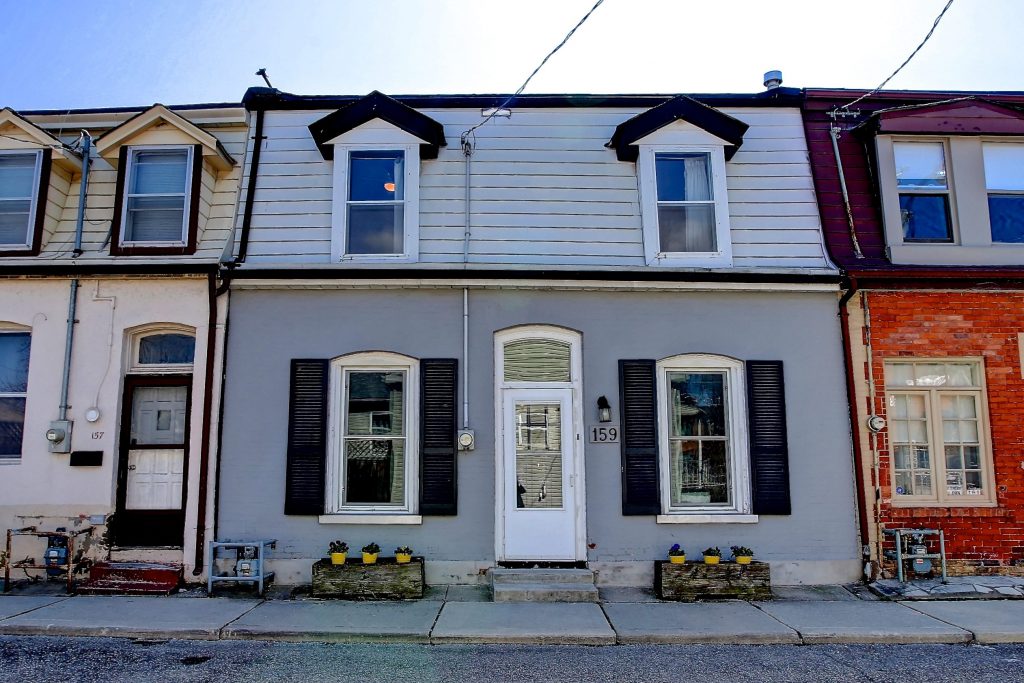
Welcome to 159 Wolseley Street, a deceptively spacious (25 ft wide) 4 bedroom row home in the sought after Trinity Bellwoods neighbourhood just a one minute walk from the Queen Streetcar and the shops, restaurants & cafes of trendy Queen West. Stroll to Trinity Bellwoods Park and enjoy the Community Centre, playground, tennis courts and soccer, football & softball fields. It’s a walkers’ & riders’ paradise: 97 Walk Score & 100 Transit Score!
The main floor features a bright open plan living/dining room with extra-large windows overlooking the sunny south facing garden. Walk out from the updated eat-in kitchen to your private back yard oasis.
The main floor also has two large bonus rooms at the front that can be used as bedrooms, offices, or for extra storage!
Upstairs there are three generous bedrooms plus a spa-like bathroom and a convenient 2nd floor laundry.
Sign Up For Our Newsletter
Looking for more great real estate content? Get it delivered to your inbox with our newsletter!
Old Mill
03/31/20
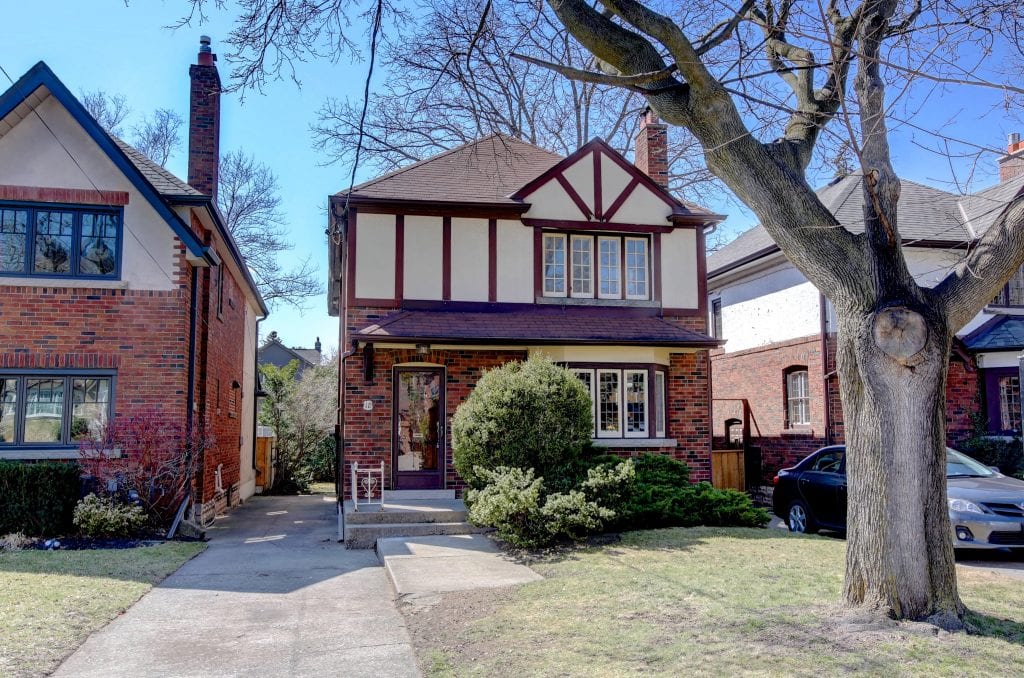
Welcome to 18 Bridgeview Road, a lovely 3+1 bedroom family home on a quiet street in the highly desirable Old Mill neighbourhood. While this home is in need of some cosmetic updates, it is roomy and bright and has beautiful original wood features.
The spacious foyer showcases the original wood wainscoting and leads to the open-concept living/dining area. The living room features a wood-burning fireplace, leaded-glass bay windows, and crown molding. French doors open to the dining room, which has built-in cabinets and an entrance from the kitchen for easy entertaining. The dining area opens to a sunny family room with lots of windows and an exit to the backyard. The backyard itself is large and incredibly private, perfect for children’s playdates, entertaining, or just relaxing in this secluded green space. The bright kitchen has lots of storage, including a pantry.
The second level features a uniquely designed master suite with a 2-in-1 tandem room, ensuite bath, walkout to a private balcony, and a walk-in closet. A skylight provides lots of natural light to the second bedroom, which has built-in shelving in addition to the closet space, and the spacious third bedroom has a double closet. This level also has a four-piece bathroom and a very large linen closet for additional storage.
18 Bridgeview Road is right in the heart of Old Mill, a scenic and historic Toronto neighbourhood. It’s steps from Etienne Brule Park, as well as the Humber River and its surrounding walking trails and parkland. Bloor West Village, with its shops and restaurants, is a short walk away, as are the Jane and Old Mill subway stations.
With its striking original features and wonderful, quiet location, this home is just waiting for the right family to make it their own.
Sign Up For Our Newsletter
Looking for more great real estate content? Get it delivered to your inbox with our newsletter!
2017 Redux Continues in Toronto
03/08/20
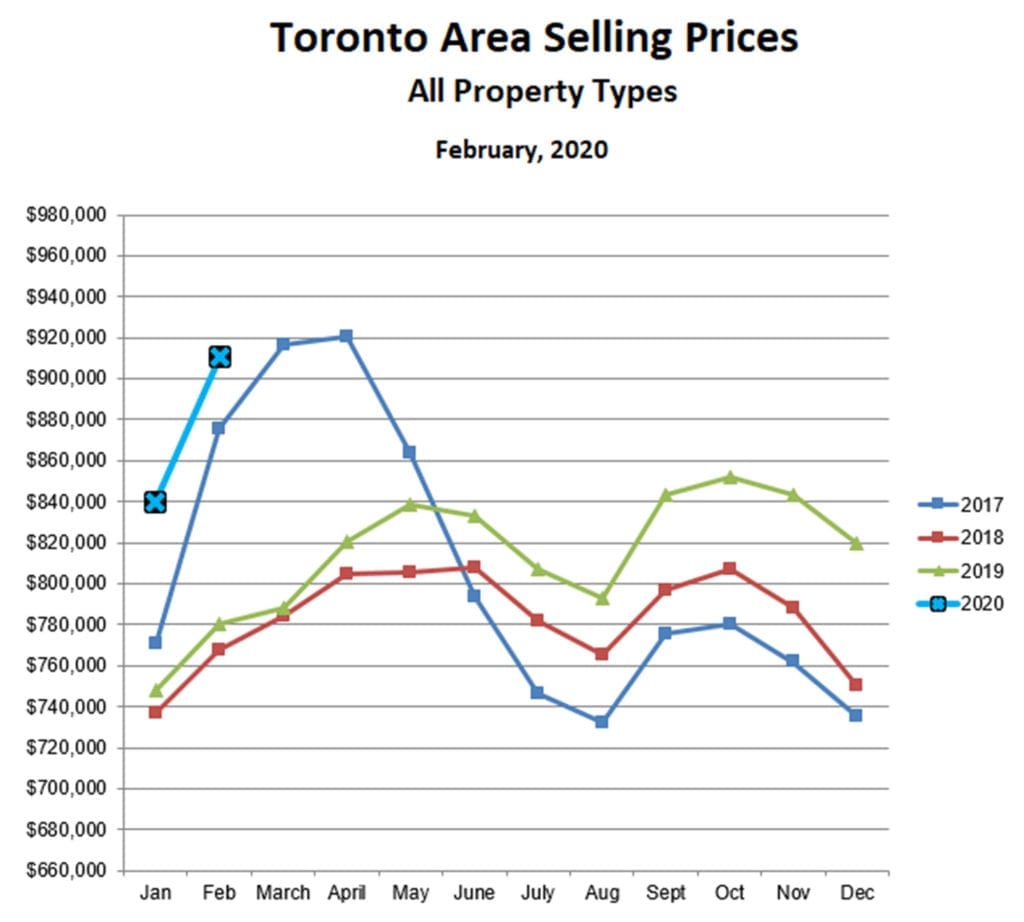
Prices for both condominium and freehold properties continued upward in February, following the trail blazed in early 2017. The market for condominium apartments, in particular, is on fire, with prices 22% higher than last February and 8% higher than the most recent all-time high reached last November.
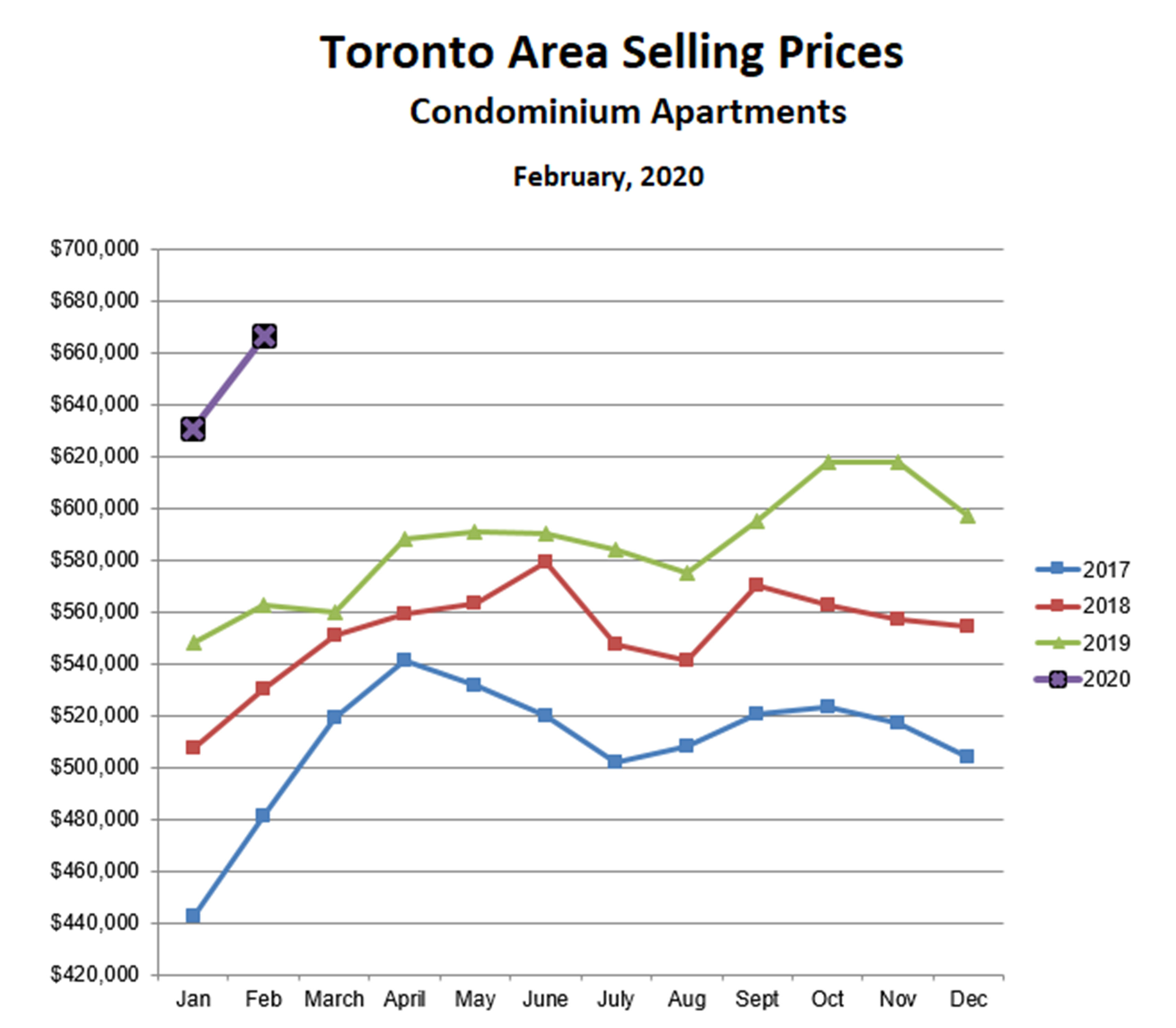
Prices for freehold properties (mostly detached homes) also moved higher in February, to 14% above last year and within 10% of the ‘bubble peak’ reached in March of 2017.
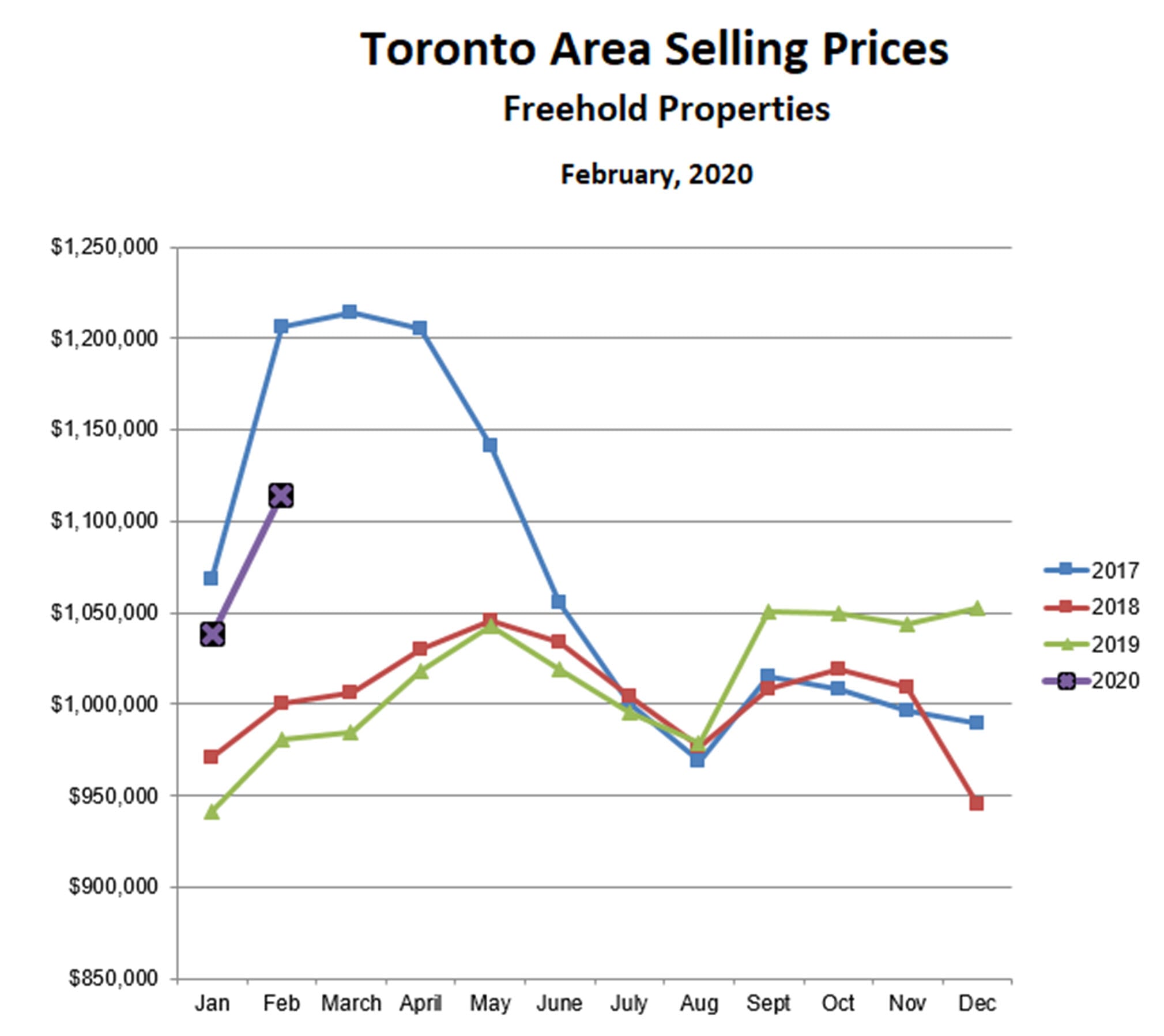
While condominium and freehold prices have followed very different pathways over the past three years since the 2017 bubble collapsed, the 2020 chart for all property types is eerily similar to 2017. Average prices in February for all properties combined were actually 4% higher than in 2017!
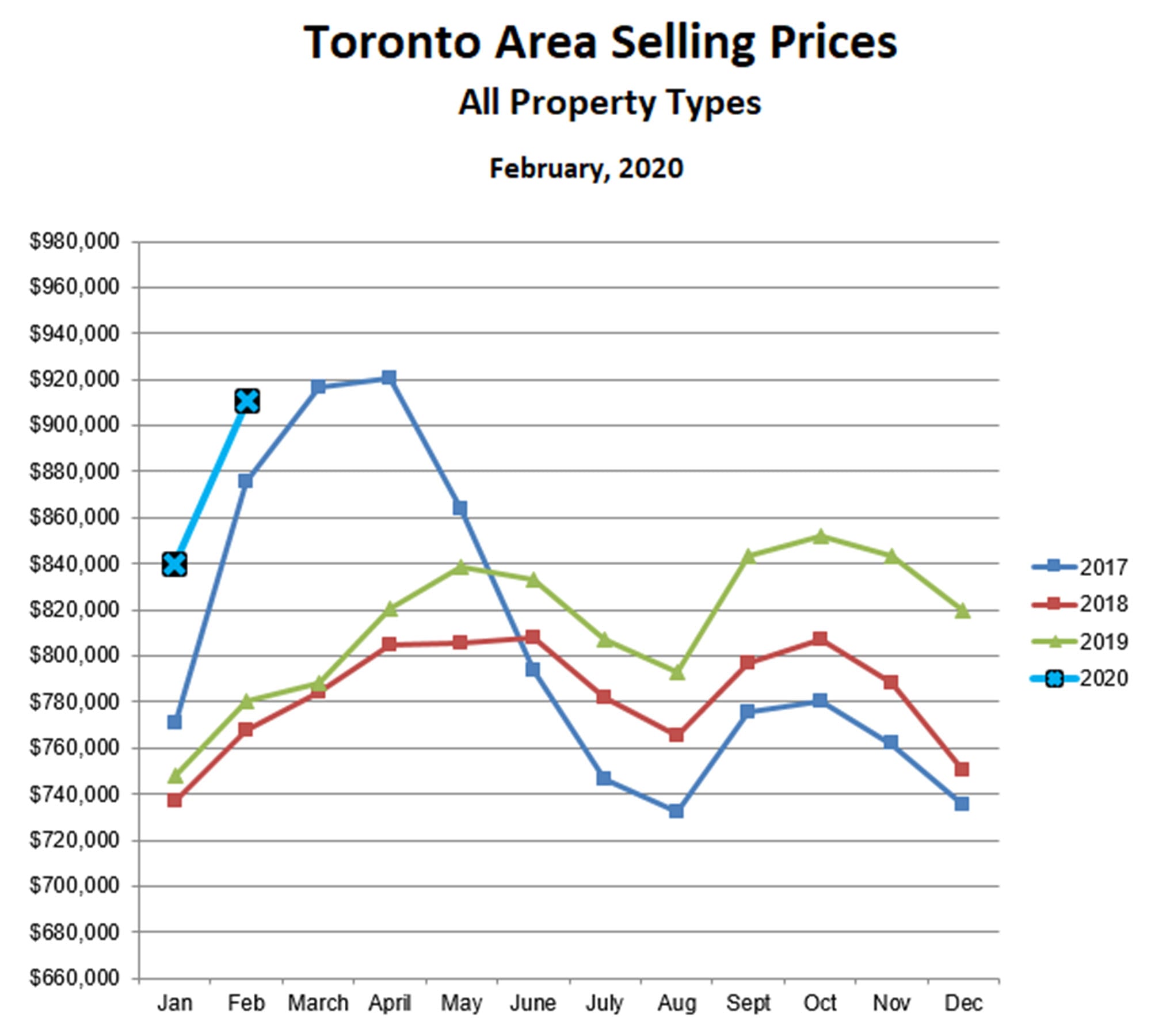
Just like in 2017, the strength of the market corresponds to low and falling inventory of homes for sale. As we have discussed previously, at some point the falling inventory/rising price pattern becomes self-reinforcing and self-accelerating, and we have probably reached that point already.
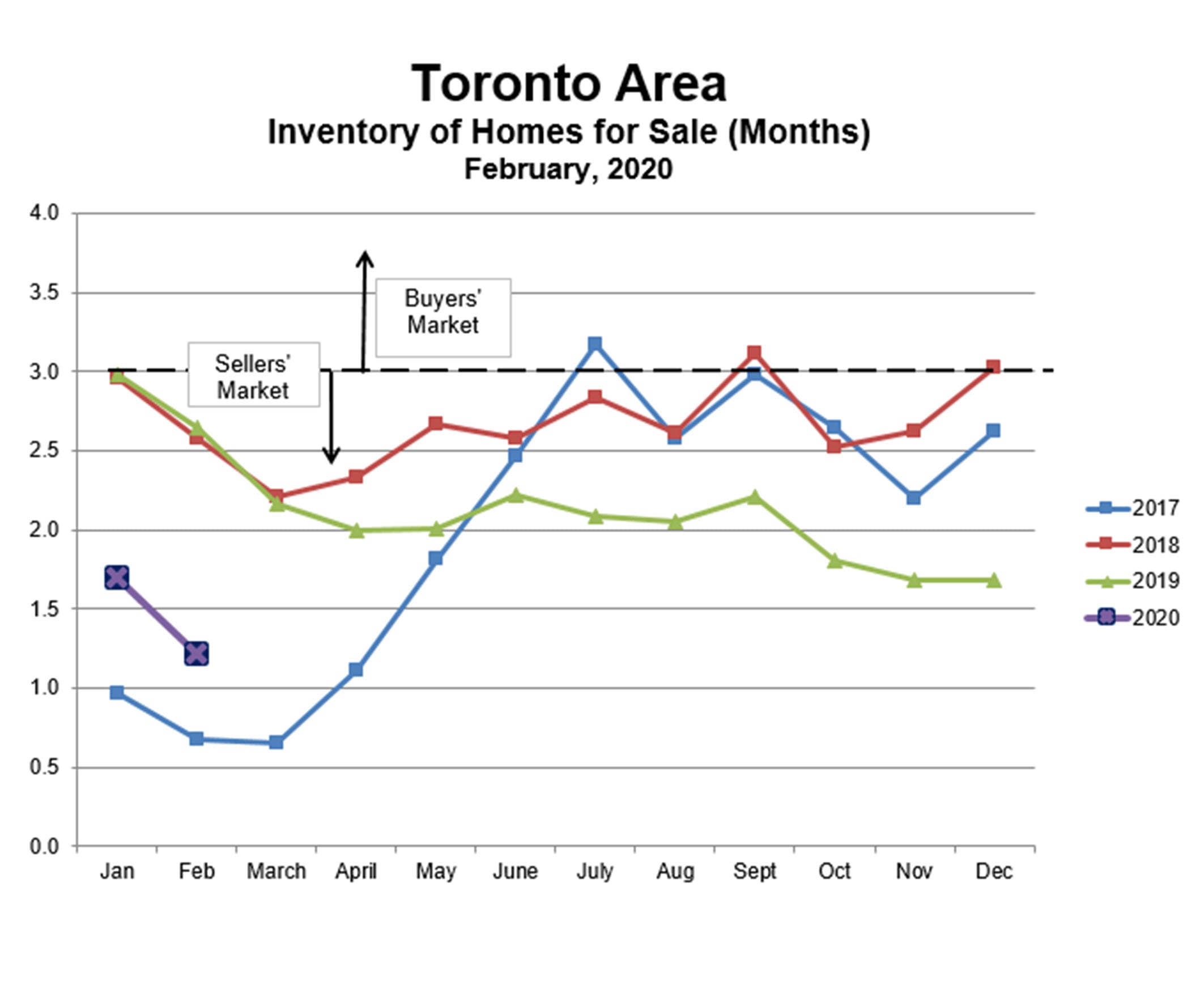
It seems clear that another 2017-like bubble is forming right before our eyes, and the recent mortgage interest rate reductions will probably add kerosene to the flames. The pin that burst the bubble in 2017 was called the “Ontario Fair Housing Plan”, a 16 point piece of government legislation that included a 15% foreign buyers’ tax. Maybe this year’s pin will be called COVID-19?
Sign Up For Our Newsletter
Looking for more great real estate content? Get it delivered to your inbox with our newsletter!
Just Sold – Renovated Roncy Gem
03/04/20
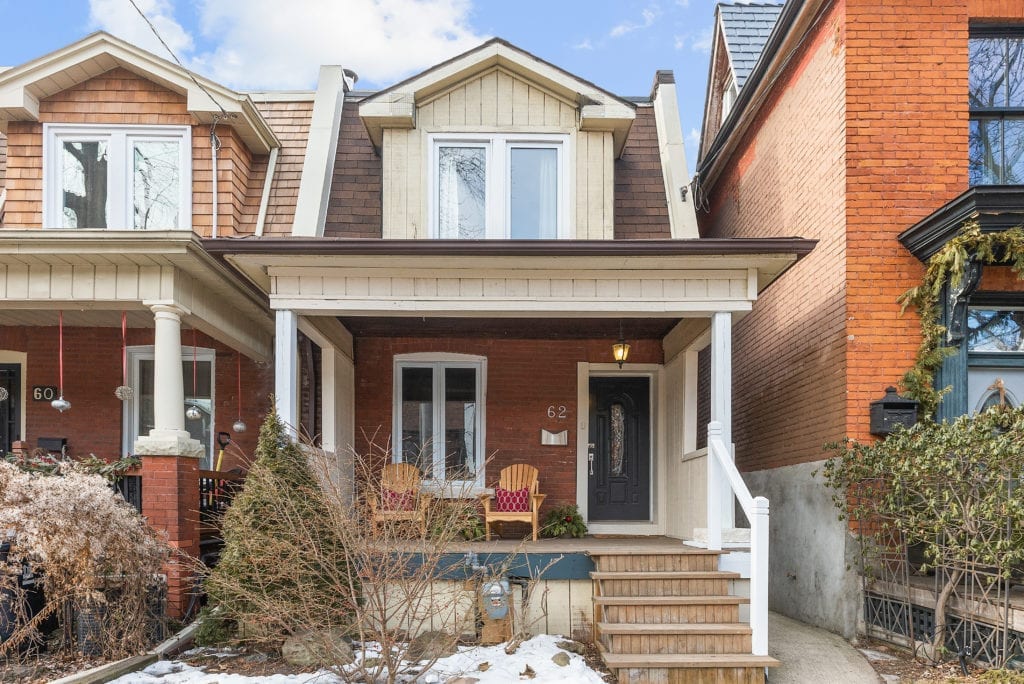
Welcome to 62 Lynd Avenue, a renovated family home with 2 car laneway parking in a prime Roncesvalles location.
An inviting covered front porch draws you in to the contemporary open plan main floor, which has recently refinished hardwood flooring, a cozy fireplace, an exposed brick accent wall and pot lighting throughout. The renovated kitchen features stainless steel appliances, granite counters, reverse osmosis water tap, and a breakfast bar with pendant lighting. What a wonderful space for entertaining with family and friends!
Upstairs there are three bedrooms, a renovated five piece bathroom with heated floors and glass double sinks, and newly refinished hardwood flooring throughout. There are also updated casement windows throughout the main floor and upper level.
The finished lower level has a three piece bathroom with a soaker tub, a rec room or fourth bedroom, and new laminate flooring throughout.
Situated in a safe and sought after neighbourhood, this home is just a short walk away from subway and UP stations, less than 30 minutes from downtown, and just down the street from High Park, the jewel of Toronto’s park system, with more than 1 million visitors each year to its 400 acres of walking trails and attractions. It’s also close to three popular shopping districts: Roncesvalles Village; The Junction; and Bloor West Village. Each has its own distinct personality and its own varied collection of cafes, shops, restaurants, fruit & vegetable markets and flower shops.
This home is in the catchment area for top rated public schools: Howard Jr PS; Fern Avenue Jr/Sr PS; and Bloor CI. Access to the excellent French Immersion programs at Howard and Fern is available to residents in this catchment area, and can be continued through High School at Humberside CI, another top rated school. Also, the highly regarded High Park Gardens Montessori School is only a 10 minute walk away.
Sign Up For Our Newsletter
Looking for more great real estate content? Get it delivered to your inbox with our newsletter!
Just Sold – Renovated Etobicoke Townhome
02/28/20
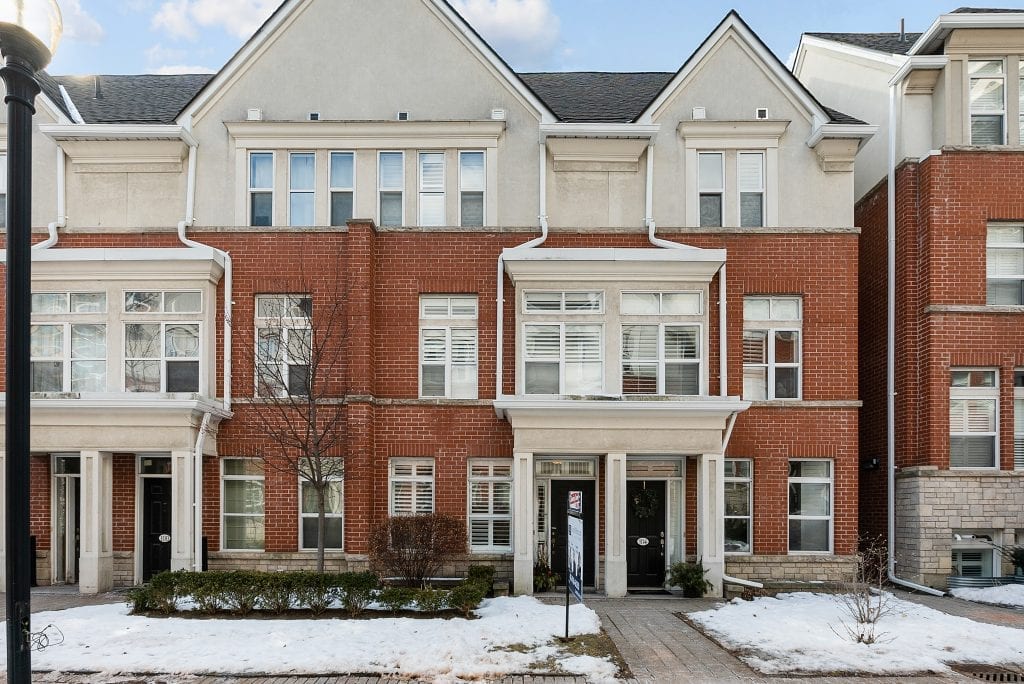
Welcome to 102 Resurrection Road, a two bedroom + den townhome in an ideal location close to subway & GO stations, Islington Village shops & restaurants, great schools, parks, and with easy access to major highways, airport and downtown.
This tastefully renovated three level townhome has an open plan living room/dining room/kitchen on the 2nd floor with a walk-out to a balcony (gas BBQ’s allowed!) and pot lighting throughout. There are custom built-in cabinets & entertainment centre in the living/dining area, and the renovated white kitchen has granite counters, a breakfast bar, and pendant lighting.
The upper level has two spacious bedrooms, each with plenty of closet space, and a spa-like bathroom with a soaker tub and a separate shower.
The main floor has a den with custom built-in cabinetry (potential 3rd bedroom), a renovated 2 piece bathroom, and access to the built-in garage.
There are hardwood floors and custom California shutters throughout all three levels.
What a great opportunity for investors or first time buyers!
Sign Up For Our Newsletter
Looking for more great real estate content? Get it delivered to your inbox with our newsletter!
Changes Coming To The Mortgage Stress Test
02/22/20

The ‘stress test’ for mortgage qualification in Canada requires that homebuyers must qualify for a mortgage as if the mortgage interest rate were higher than the actual rate they will get. The idea is to determine that the applicant will be able to keep up with the payments if interest rates should rise. That ‘higher rate’ is either the actual interest rate + 2% or the governments “Mortgage Qualification Rate” (MQR), whichever is greater.
Until now, the MQR has been equal to the mode of the chartered banks’ posted rates, however, as of April 6, the MQR will be the weekly median 5-year fixed insured mortgage rate from mortgage insurance applications, plus 2%. This will make the MQR more directly responsive to changes in actual mortgage rates, as the rates posted by the chartered banks are largely for show and do not closely follow the ‘real’ rates they charge to mortgage lenders.
For now, the change in the MQR only applies to insured mortgages, though it seems likely that it will be extended to uninsured mortgages as well.
This is a pretty small tweak to the stress test, and won’t make a significant difference to how much a lender can qualify for. The biggest impact will be on responsiveness – the new MQR will change on a weekly basis as mortgage rates change, not just whenever the banks decide to change their posted rates.
Sign Up For Our Newsletter
Looking for more great real estate content? Get it delivered to your inbox with our newsletter!
Toronto Market Continues to Accelerate
02/08/20
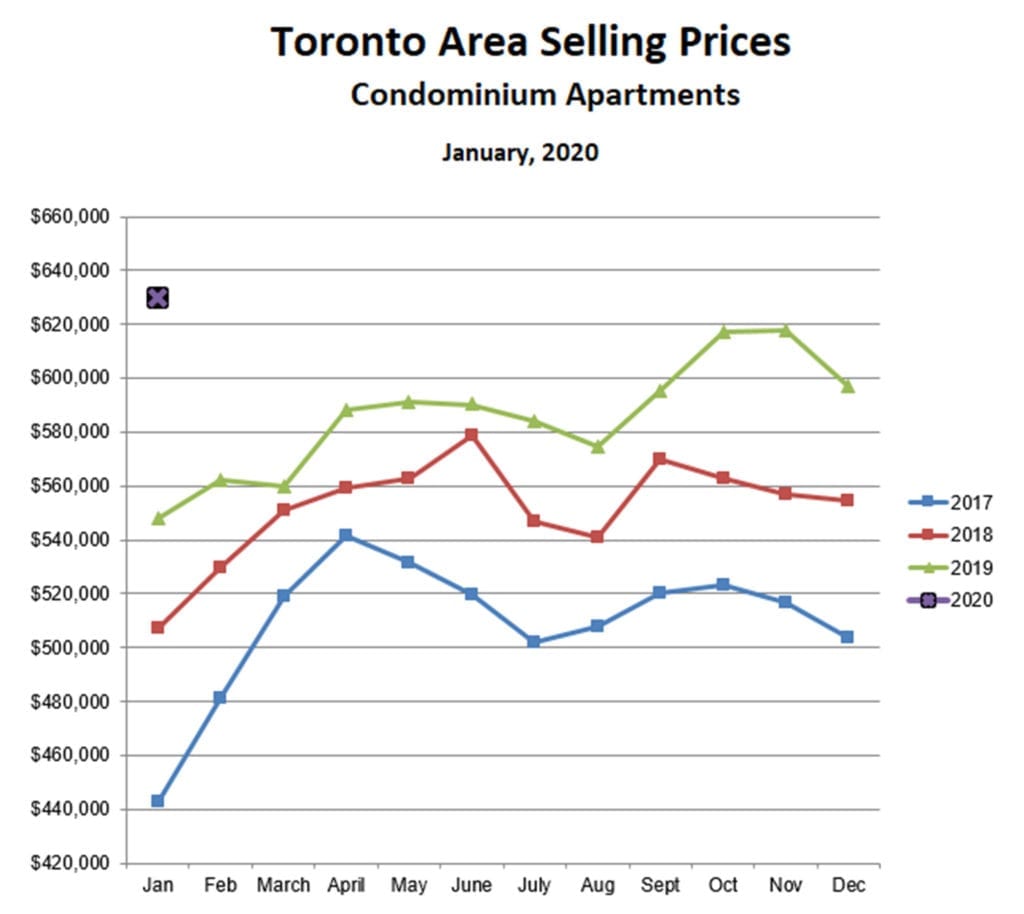
It’s beginning to look a lot like 2017.
Three years ago we had an insane spring market, with house prices rocketing upward by 20% and then crashing back down to where they started. The entire process only took about five months from beginning to end. The bubble was driven primarily by extremely low inventory of homes for sale and ended because of Ontario government legislation aimed (very successfully) at cooling off the market.
Following the collapse of the 2017 bubble, prices for freehold properties remained flat to slightly declining for the next two years. Then, last September, house prices increased sharply and continued to strengthen right through December, when normally the market sags a bit. The trend is continuing this year. Although January house prices are slightly below December, they are 10% higher than last January, and not far from the average price in January 2017.
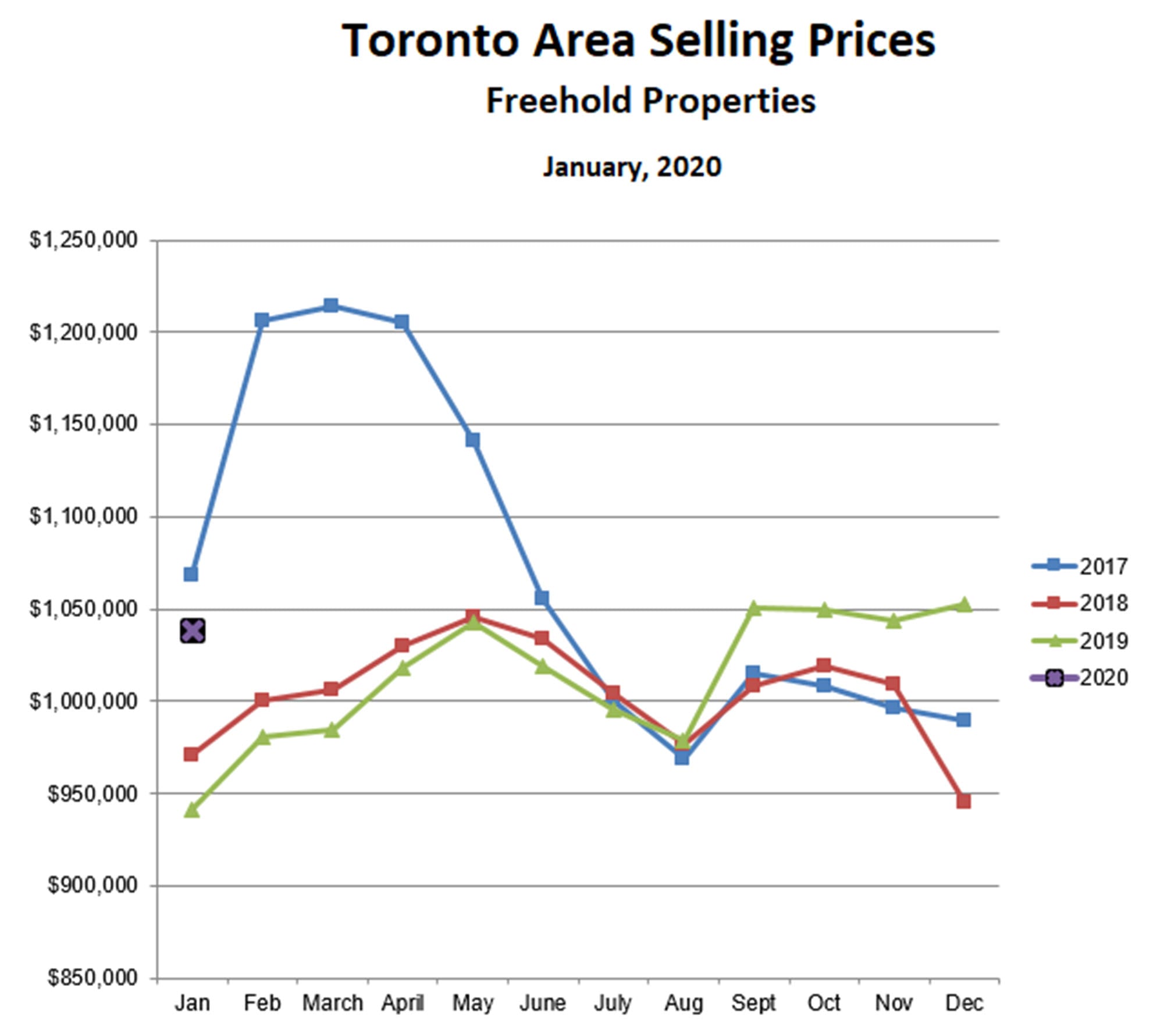
The market for condominium apartments in the GTA is even stronger than for houses. Back in 2017, condo prices also increased dramatically in the spring (by more than 20%) and also pulled back after April. However, condo prices did not collapse all the way back to where they started, and have continued to push higher ever since. Condo prices in January were 5% higher than December, 15% higher than last January, and 16% higher than the ‘bubble peak’ in April of 2017. While affordability (vs houses) is obviously one reason why the condo market is so strong, it is perhaps not the most important reason. The rental market in the GTA is extraordiarily tight and in fact could be described as a crisis situation. There simply aren’t enough rental units available to satisfy the steadily increasing demand. The primary source of new rental units is condominium apartments, and so condos have become very attractive to investors, to the point where they are starting to ‘crowd out’ end users. Also, many move-up buyers who bought condos a few years ago and now want a house are deciding to keep the condo for the rental income instead of putting it up for sale. The bottom line is that the demand for condos is growing faster than the supply.
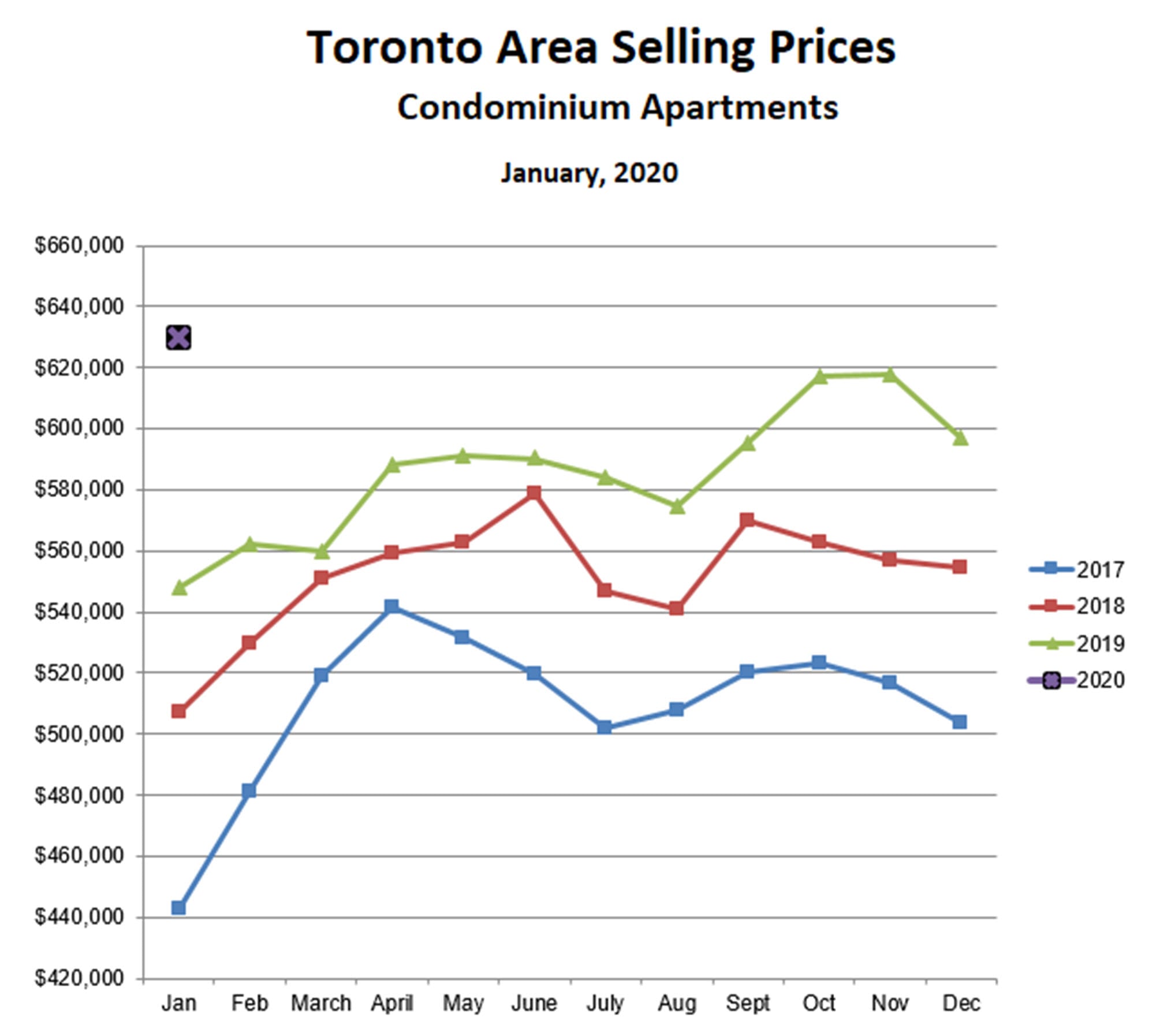
The increasing demand for both houses and condos relative to supply is reflected in the steadily declining inventory of homes for sale. For the past four months, overall inventory has been at less than 2 months’ supply, very deep in ‘sellers’ market’ territory, and lower than at any time since the 2017 bubble. While we still have a ways to go to match the extremely low (less than 1 month’s supply) levels seen in early 2017, we are definitely trending in that direction. We are getting close to the point where the increases in the market become self-reinforcing, if we aren’t already there. As inventory falls, it gets harder to find a house to buy and easier to sell the house you’ve got. So more and more move-up buyers decide to buy first before they put their house up for sale and, since a high proportion of homes for sale belong to move-up buyers, this means that the tighter the market gets, the more it tends to get even tighter.
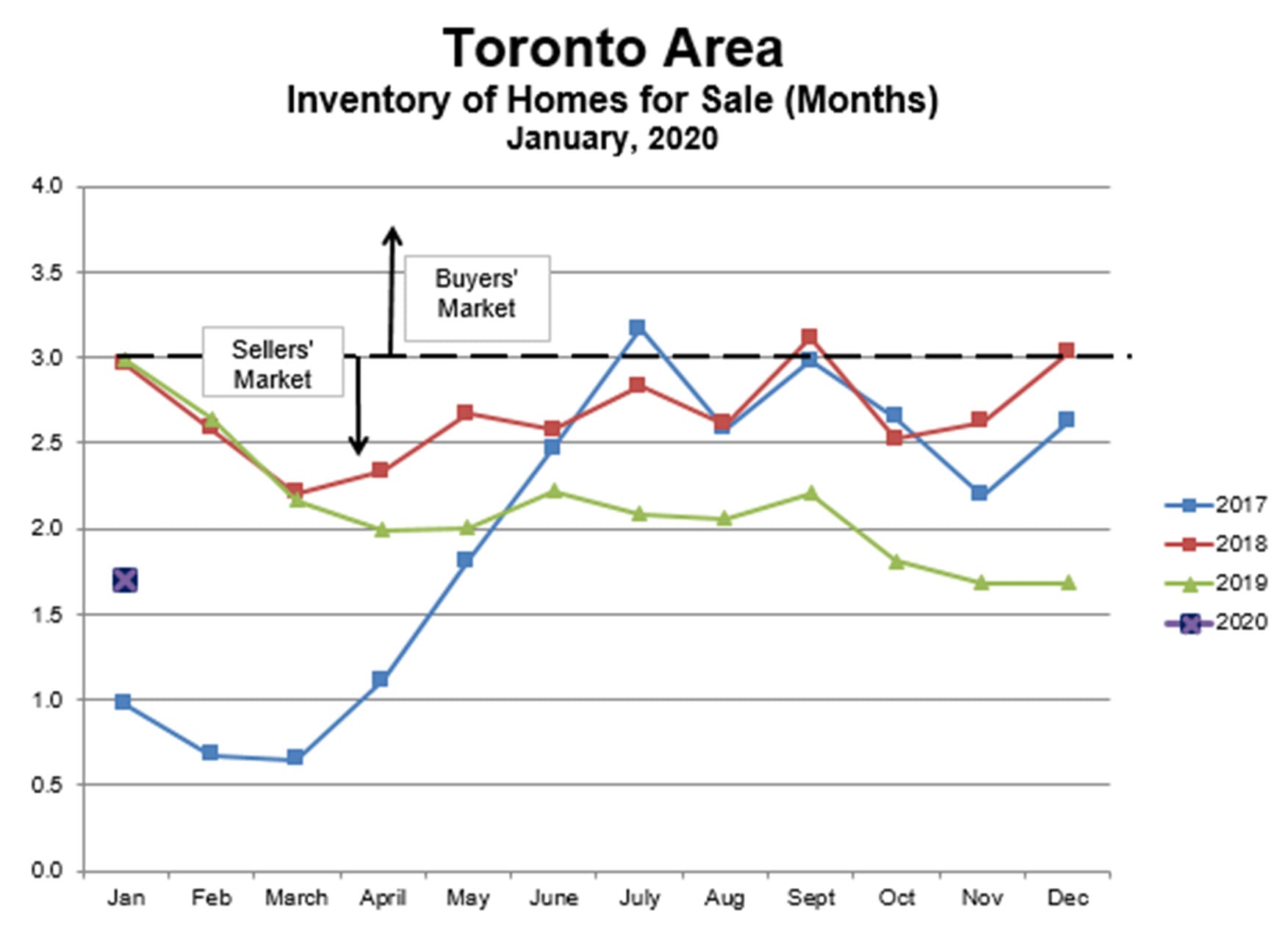
Unless the government once again decides to intervene to cool off the market… and as long as the coronavirus outbreak soon comes under control… and as long as there are no dramatically negative financial, economic or geopolitical events, the spring market should continue to be very strong for at least the next 3-4 months.
Sign Up For Our Newsletter
Looking for more great real estate content? Get it delivered to your inbox with our newsletter!








